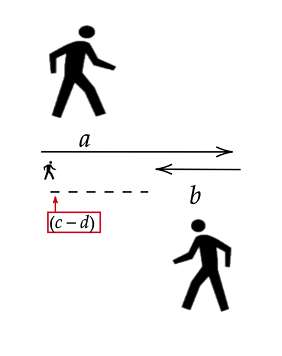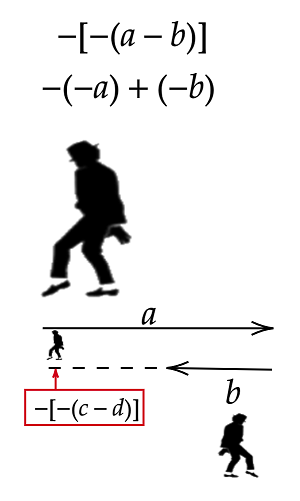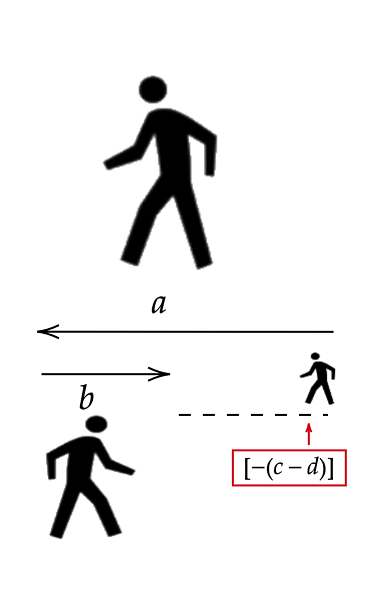Post History
#2: Post edited
- **(1)**
- $$\dfrac{a - b}{c - d}$$
- 
- As the image depicts, $(a - b)$ means $a$ steps forward and $b$ steps backward which results in net $(a - b)$ steps, and dividing it by $(c - d)$ gives the number of steps (of **length** $(c - d)$) in $(a - b)$.
- <hr>
- **(2)**
- $$\dfrac{{{-}}(b - a)}{{{-}}(d - c)}$$
- 
- $-(b - a) \implies -[-(a-b)] \implies -(-a)+(-b)$ which means $a$ steps forward by facing backward and similarly $b$ steps backward which again results in net $(a - b)$ steps, dividing it by $-[-(c - d)]$ (here the negative sign indicates the way length $(c - d)$ was measured. See the figure) gives the number of steps (of **length** $(c - d)$) in $(a - b)$.
- Just like (1)
- <hr>
- **(3)**
- $$\dfrac{b - a}{d - c}$$
- 
- Now can you intuite how is $\dfrac{b - a}{d - c}$ related to $\dfrac{a - b}{c - d}$ ?
- <hr>
- **P.S.:** I have used 'length' in place of 'steps' in some sentences, this was done to not make the explanation complex. They don't really mean the same but are closely related.
- **(1)**
- $$\dfrac{a - b}{c - d}$$
- 
- As the image depicts, $(a - b)$ means $a$ steps forward and $b$ steps backward which results in net $(a - b)$ steps, and dividing it by $(c - d)$ gives the number of steps (of **length** $(c - d)$) in $(a - b)$.
- Intuitive Meaning of Division can be found [here](https://betterexplained.com/articles/division-intuition/).
- <hr>
- **(2)**
- $$\dfrac{{{-}}(b - a)}{{{-}}(d - c)}$$
- 
- $-(b - a) \implies -[-(a-b)] \implies -(-a)+(-b)$ which means $a$ steps forward by facing backward and similarly $b$ steps backward which again results in net $(a - b)$ steps, dividing it by $-[-(c - d)]$ (here the negative sign indicates the way length $(c - d)$ was measured. See the figure) gives the number of steps (of **length** $(c - d)$) in $(a - b)$.
- Just like (1)
- <hr>
- **(3)**
- $$\dfrac{b - a}{d - c}$$
- 
- Now can you intuite how is $\dfrac{b - a}{d - c}$ related to $\dfrac{a - b}{c - d}$ ?
- <hr>
- **P.S.:** I have used 'length' in place of 'steps' in some sentences, this was done to not make the explanation complex. They don't really mean the same but are closely related.
#1: Initial revision
**(1)**
$$\dfrac{a - b}{c - d}$$

As the image depicts, $(a - b)$ means $a$ steps forward and $b$ steps backward which results in net $(a - b)$ steps, and dividing it by $(c - d)$ gives the number of steps (of **length** $(c - d)$) in $(a - b)$.
<hr>
**(2)**
$$\dfrac{{{-}}(b - a)}{{{-}}(d - c)}$$

$-(b - a) \implies -[-(a-b)] \implies -(-a)+(-b)$ which means $a$ steps forward by facing backward and similarly $b$ steps backward which again results in net $(a - b)$ steps, dividing it by $-[-(c - d)]$ (here the negative sign indicates the way length $(c - d)$ was measured. See the figure) gives the number of steps (of **length** $(c - d)$) in $(a - b)$.
Just like (1)
<hr>
**(3)**
$$\dfrac{b - a}{d - c}$$

Now can you intuite how is $\dfrac{b - a}{d - c}$ related to $\dfrac{a - b}{c - d}$ ?
<hr>
**P.S.:** I have used 'length' in place of 'steps' in some sentences, this was done to not make the explanation complex. They don't really mean the same but are closely related.


















